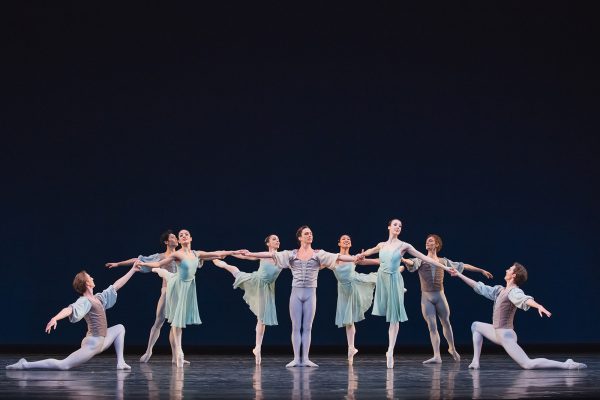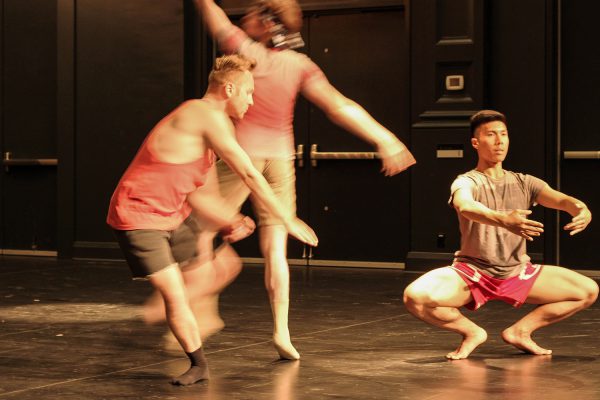DanceWorks, Toronto’s prestigious contemporary dance series, often programs joint concerts that feature shorter works. It is a clever idea on the part of curator Mimi Beck, because it allows for new creations without a choreographer having to self-produce an entire evening.
One can certainly understand Beck’s twinning of Denise Fujiwara and Susie Burpee (whose pieces were 30 and 40 minutes respectively). Both artists are veteran dancesmiths whose reputations guarantee masterfully crafted choreography. Their works are anchored in the heart of darkness of the human psyche, and usually involve symbolic props and design. While Fujiwara’s intensity is focused on singular moments, Burpee’s intensity is a whole cloth that embraces an entire work. Characterization dominates their pieces.
In the case of Fujiwara, the modus operandi of her physicality is butoh, the nihilistic art form that began in 1950s Japan, spawned by the horrific destruction of the atom bomb. Deliberately flying in the face of centuries old Japanese aesthetic conventions that glorified beauty and harmony, butoh is glacially slow, lovingly caressing every small detail as a pearl to be savoured, no matter how ugly or distorted.
Burpee, on the other hand, is firmly rooted in post modernisms, even pedestrianisms. She finds movement specifically suited to character and theme, drawn from the physicality of quotidian life. A simple breath or a shudder can take on a meaning of vast importance. Even at her most heartbreaking, there is always irony.
Fujiwara’s world premiere solo, “Lost and Found”, is about a woman in crisis. Her arthritic clenched fists, her halting impulse of movement, her inability to rise off the floor, all lead to the conclusion of old age. We soon discover that she is emotionally, rather than physically crippled. The “Lost and Found” of the title could refer to her own seeming paralysis and the awareness that she is both looking back and forward at the same time.
The metaphors are on stage at the very beginning. There is a wooden animal carrying cage that in my mind symbolizes the pejorative cliché that she is a single woman of a certain age who owns a cat. A small turquoise bird’s egg is ultimately placed in her bird’s nest hat, which is tied under her chin with a big pink ribbon. Is she the egg that opens to freedom, or the cage that shuts her in a mental prison?
Roelof Peter Snippe’s lighting grid of squares reinforces the confinement motif, while Philip Strong’s electronica music is mostly of delicate, staccato pings mirroring the woman’s fragility. The soundscape also contains metaphors such as the cries of free-flying birds and the shattering of glass. Both midway through the piece, and at the very end, we hear the same footsteps walking away into the distance. At the mid point, those steps suggest wishful thinking, while at the end, perhaps, we are left wondering if they announce the fledgling leaving the nest.
Germane to the theme is visual artist Janieta Eyre’s über-feminine costume design, which includes layers of clothing that Fujiwara sheds throughout the piece. She begins in a body-concealing pink housecoat and voluminous white crinoline; by the end she is garbed in the more revealing short pink slip covered by a pale green bustier as befits the sexual subtext. The most intriguing design element is what can only be described as pantyhose for the arms, which keeps Fujiwara’s fingers closely held together, turning her hands into arrowheads, a clever image for a work about finding new directions.
Initially, the woman tries to stand erect, never making it past the knee crouch, falling down and rolling over again and again. Fujiwara is a master of control, and never shows strain, no matter how long she has to hold a position, a physical skill honed by her butoh training. When the woman finally does arise, she mimes the climbing of a ladder – another clever metaphor. When she speaks, she declares that she has issues she is attached to, borne out by the indecisive choreographic language of the whole.
Her haunted face, slow motion walks, arched-back monkey crawls, undulating and shuddering body motifs, gentle leans to the front and sudden pull-backs, the occasional fall, the back and forth directional bias, the distracted hand gestures, the clutching of heart and head, arms stretched out in longing – collectively they create the work’s push me/pull me dynamic. Towards the end, Fujiwara engages in almost child-like, side-to-side body swings, and back-and-forth rocking. Her body and face puff up with air, and she raises her arms – but is this truly the breath of freedom?
“Lost and Found” is a compelling dance portrait. It is not so much originality of theme that makes Fujiwara eminently watchable, but her careful construction of the visual/physical manifestation.
“Fidelity’s Edge”, Burpee’s duet for herself and collaborator Dan Wild (Burpee credits Wild in the program as being an integral part of the creative process), premiered at Peterborough New Dance in 2009. It is a companion piece to her award-winning “Mischance and Fair Fortune” (2005). In that work, inspired by the myth of Pyramus and Thisbe, the two lovers never physically came together. “Fidelity’s Edge” conjures up the tantalizing picture of what might happen if they did meet. It is not a dance for the faint of heart.
The duet is an intimate look at a dysfunctional romantic relationship. Its edgy side is the mind and/or sexual games these lovers play with one another. They are rarely on the same page at the same time. While Wild’s character does get his licks in eventually, it is Burpee’s woman who is the driver. Their battlefield includes a comfortable red armchair, a white shag rug, and the flickering light of a television set. The stage beyond the rug becomes a place of downtime or time-out.
The five original recorded songs of Winnipeg composer/singers (and life partners) Christine Fellows and John K. Samson fit the power struggle like a glove. One song is about sticking through the hard times of unpaid bills, while another expresses the primal need of not being alone. Burpee never falls into the trap of mirroring words. Rather, the songs reflect mood or even irony in the choreography. They function like a cinema soundtrack, and their deceptively simple lyrics cut deep to the heart of a troubled relationship.
Burpee’s signature for the woman is incomplete movement: arm gestures that halt in mid-air, turns abruptly curtailed, forward motion that suddenly reverses itself. Before finishing the actual physical act, she is engaged in something else – an impulsive, kinetic delivery that mirrors her inner demons. She is an agent provocateur, a purveyor of devotion and revulsion in equal measure. The man is more reactive until his anger overwhelms him and he becomes physically abusive.
In the opening, the two walk in from opposite directions. When they meet, their fingers flutter through the air, limning each other’s body. When they do touch, it is with the force of an electrical charge, causing their bodies to shudder. Burpee, in particular, begins to telegraph her malaise through semaphoric gestures. For example, her arms outthrust from the body in parallel lines pump furiously up and down in alternating directions. Her hands chop and dice the air in contrast to Wild’s erotic embraces. She pretends to collapse in his arms, but it is a ruse to throw him off balance. This identical movement pattern also ends the work, with the lovers walking off in opposite directions. Their bitter encounters, it would seem, are a repeating cycle of torment.
In between these bookends is a wild cacophony of love/hate physicality intercut with snapshots of tenderness. At the heart of their passionate struggle is confrontation (her) and passive-aggression (him). At one point, Burpee forces Wild to become a human top, whirling him around like a toy. She taunts him with a Keystone Kop (open knee, heels together) walk. She poses in an arabesque like a ballet diva commanding her partner to take his position. They fight over which song to play on the tape recorder. They lunge like duellists, grasp at each other like greedy children, and roll entwined on the floor in a mutual tantrum. He grabs a pillow from the chair to be his shield, and she throws herself at this human punching bag with relentless determination. In desperation, he pushes the chair as close to the TV screen as he can get.
This relationship is like mercury, fluid and unpredictable. It is melodrama anchored in the seething maw of lust, and both dancers wear their heart on their sleeve through punishing, high-energy physicality. The title, “Fidelity’s Edge”, says it all. For a relationship fraught with tension, the make-or-break fault line is dangerously close at hand.
In the final analysis, there is something very satisfying about the mature works of senior artists such as Fujiwara and Burpee. To have an idea for creation is one thing; to be able to develop that idea into a meaningful artistic journey is the fruit of years of experience.
Tagged: Butoh, Contemporary, Performance, ON , Toronto





